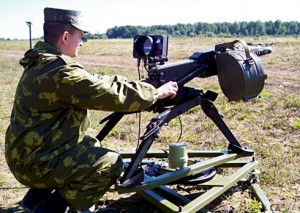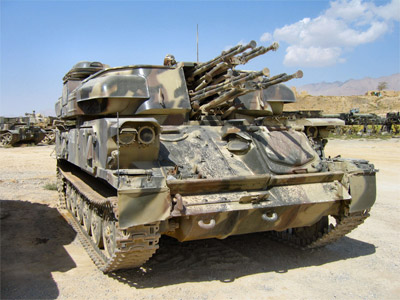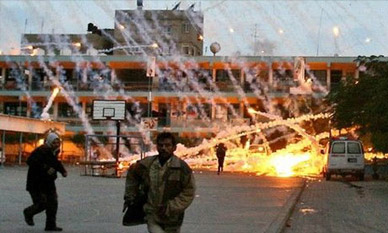
The picture shows a Russian soldier firing an AGS-17 (Plamya) automatic grenade launcher with SOVA (Owl) sights. The Plamya fires a 30mm grenade at 185 m/s, which is less accurate and less powerful than the 40 mm grenades of the U.S. Mk 19. But the Plamya is half the weight of the Mk 19 (a little less than a Kord machine gun) and does not jam as often as the Mk 19; it requires a crew of only two men. At 400 m it has a mean deviation of 4.3 m in range and 0.2 m sideways. Thus, it has 95% chance of placing its rounds in a strip 1.2 m across and 25.8 m long. It has a kill radius of 7 – 9 m. The Plamya is more effective than the Mk 19 in rural combat, like Russia’s invasion of Afghanistan, because it can be carried over rough terrain by two men, but its small grenades make it less effective in urban combat where such weapons are almost always mounted on vehicles so weight is not a problem but punching through walls can be. The principle reason that I call this weapon system the sniper’s greatest fear is the sighting system. The SOVA, also called the Owl, uses the shock wave of a sniper’s bullet to locate the shooter. This is similar to the U.S. Boomerang, but (at least according to Russian literature) better. The Boomerang has up to a 15° error on azimuth angle, which is too great to be used for direct fire control. Thus, the Boomerang only provides an LED on a clock-like display and an audible warning of incoming shots; e.g. “shot, 7 o'clock." The Mk 19 gunner must visually locate the target and aim for it using the weapon’s conventional sights. The SOVA can locate a sniper out to 600 m and within a 1° error on azimuth angle. This is accurate enough to directly target him or her with grenades, even if the Plamya gunner is blinded by a smoke screen. At 400 m a 1% error is 7 m, which is within the Plamya’s kill radius; at 600 m a 1% error is 10.5 m, though the gunner can always walk his grenades across the target area. In contrast, at 400 m the Boomerang could be off by as much as 105 m, too great an error to even identify the correct building, much less the window from which the shot came.
What is the only effective counter-measure to a Shilka upgraded with the SOVA? Click here to find out. Unfortunately, the U.S. does not have anything like this; the Russians have developed an effective counter-sniper weapon and the only counter-counter-sniper weapon which works in cities where there are vertical walls to hide behind. In the meantime, the U.S. has been bogged down in Afghanistan and has forgotten that half of the world’s population lives in cities and, from a strategic perspective, it is the important half, especially those in deep-water port cities. In an urban environment with high vertical walls everywhere, we have neither means to counter enemy snipers nor means to defend our own snipers from the enemy’s counter measures. Inexplicably, urban combat is just not a priority for the U.S. Army. Note. Note that conventional sniper doctrine claims that the sniper’s greatest fear is other (and presumably better) snipers. This might have been true in Carlos Hathcock’s day, but motorcycle-mounted snipers in an urban environment can easily outflank a 1000-yard shooter employing the creeping stealth tactics popularized by Hathcock. Also, if he is lying in a field of grass like on Hathcock’s famous mission against the NVA general, you could just drive back and forth until you crushed him under the tracks. Thus, the existence of a gillie-suit-wearing 1000-yard champion among the enemy’s ranks is no cause for alarm. Also, while I hate to cast doubt on a man of almost legendary status, I think some of Hathcock’s stories were fictional. For instance, if the U.S. Army knew that an NVA general was at a specific location at a specific time, why didn’t they just have every artillery piece within range fire on that house simultaneously? While sniper duels of the type described in Hathcock’s book or in the movie Enemy at the Gates make great cinema and can be quite inspiring (it really is a good movie) such mano-a-mano confrontations are not the deciding factor in a battle like Stalingrad. What is needed more than individual heroism or the occasional jaw-dropping 1000 m shot is consistent medium-range gunnery from hundreds of designated marksmen who have purchased my Sniper Flash Cards and studied them diligently. People sometimes ask, what is different between the tactics that you teach and those taught by the Army Sniper School? In a word, I assume that the enemy has armor and helicopters. Army snipers simply find the tallest building in town, have a Blackhawk insert them on the roof and plink at anyone carrying any type of a weapon, usually an AK, lamenting the fact that they are not allowed to shoot those with cell phones, whom they suspect are forward observers for the enemy’s mortar gunners. If you suggest that a Hind might strafe their rooftop, a Nona might shell it or a Shilka might shoot back at them, they just give you a blank look. Hind? Nona? Shilka? What do these words mean? Or perhaps they are vaguely aware that these are enemy vehicles that were destroyed by the Air Force long before any snipers were sent forward. In contrast, I assume that there are Hinds overhead, Nonas and Shilkas (as well as T-90s, BMP-3s, BTR-80s, etc.) on the ground and that the only vehicles your side possesses are motorcycles. Note
In this paper I am just reporting on Russian-language literature about the SOVA, which may well be exaggerated. If anybody following this website has captured a Plamya with Owl sights, I would be very much interested in learning how well it performs in actual tests. It is a fact that the Russians aim their weapons with the SOVA (it is mostly used, not against snipers, but by the Hind to locate anti-aircraft guns and target them with missiles) while we offer the gunner only verbal hints on where to look for targets, presumably because the Boomerang is not accurate enough to be integrated directly into the fire control system. However, to say that the Owl is fifteen times more accurate than the Boomerang smacks of propaganda. Also, to my knowledge, the Russians have not upgraded their Shilkas with Owl sights at this time (January 2012), though this is an obvious next step and I would be interested in learning when and at what rate such upgrades are taking place.
When I speak of the sniper's greatest fear, I mean of weapons directed specifically at him. Of course, the greatest fear of the sniper, and of the civilians whom he is trying to protect, is white phosphorus. Stay off the rooftops! |
||
 God forbid that the Russians should integrate their SOVA with the Shilka’s fire control system. In an urban environment there are very few buildings that can protect one from the Shilka’s four 23 mm autocannons. And, with its ability to elevate its guns to 85°, one cannot get above a Shilka as one can get above a T-90 tank.
God forbid that the Russians should integrate their SOVA with the Shilka’s fire control system. In an urban environment there are very few buildings that can protect one from the Shilka’s four 23 mm autocannons. And, with its ability to elevate its guns to 85°, one cannot get above a Shilka as one can get above a T-90 tank.

